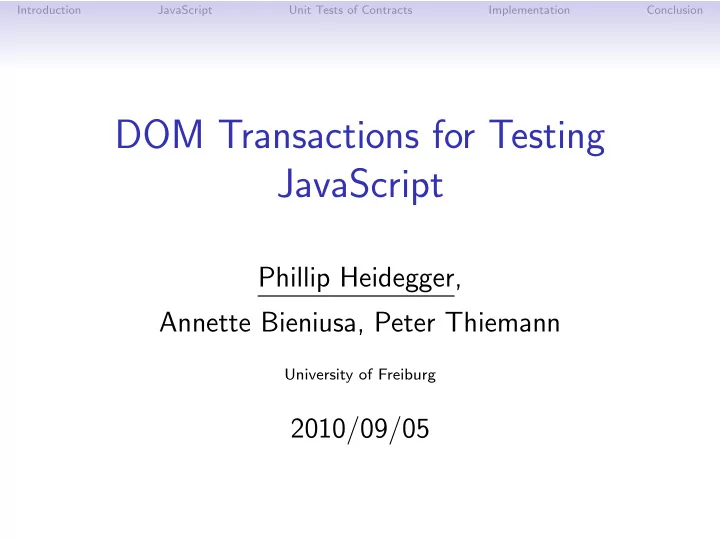

Introduction JavaScript Unit Tests of Contracts Implementation Conclusion DOM Transactions for Testing JavaScript Phillip Heidegger, Annette Bieniusa, Peter Thiemann University of Freiburg 2010/09/05
Introduction JavaScript Unit Tests of Contracts Implementation Conclusion Setting: Whitebox Unit Testing of JavaScript Code 1 / ∗∗ object → bool ∗ / 2 function h(x) { if ((x) && (x.longpropertyname)) 3 return ”false” ; 4 return true; 5 6 } ;
Introduction JavaScript Unit Tests of Contracts Implementation Conclusion Setting: Whitebox Unit Testing of JavaScript Code 1 / ∗∗ object → bool ∗ / 2 function h(x) { if ((x) && (x.longpropertyname)) 3 return ”false” ; 4 return true; 5 6 } ; • Find counter example for contracts • Finding bugs in JavaScript programs • Understanding JavaScript programs
Introduction JavaScript Unit Tests of Contracts Implementation Conclusion JavaScript – Features Some important features: • Weak, dynamic typing • Object-based language (no classes, but prototypes) • Functions are first class values • Side effects
Introduction JavaScript Unit Tests of Contracts Implementation Conclusion Checking Contracts of pure Functions • Monitoring of contracts (assertions) • Unit Testing with random generated data • Generate random data for parameters • check return contract • Isolated test cases
Introduction JavaScript Unit Tests of Contracts Implementation Conclusion Checking Contracts of pure Functions • Monitoring of contracts (assertions) • Unit Testing with random generated data • Generate random data for parameters • check return contract • Isolated test cases Side Effects ? �
Introduction JavaScript Unit Tests of Contracts Implementation Conclusion Side effects? Why not include side effects in the contracts? • Programmers typically introduces contracts incremental • Contracts do not specify the complete behavior of the system Default is: • Everything that is not forbidden, is allowed
Introduction JavaScript Unit Tests of Contracts Implementation Conclusion Handling Side Effects 1. Contracts with a setup and teardown function • Means a lot of work 2. Restart browser after each test run • Takes seconds 3. ?
Introduction JavaScript Unit Tests of Contracts Implementation Conclusion Handling Side Effects Transactions on HTML pages
Introduction JavaScript Unit Tests of Contracts Implementation Conclusion Transactions Body of our test loop: • Begin a transaction • Generate test data • Run unit under test • Check contract • Revert changes
Introduction JavaScript Unit Tests of Contracts Implementation Conclusion Implementation • Integrated into JSConTest • Contracts for Specification • Random Testing • Guided Random Testing • Log based transactions • Transformation of code under test • Browser independent
Introduction JavaScript Unit Tests of Contracts Implementation Conclusion Implementation • Integrated into JSConTest • Contracts for Specification • Random Testing • Guided Random Testing • Log based transactions • Transformation of code under test • Browser independent We can not revert every side effect, but − → setup / teardown or browser restart is rarely necessary
Introduction JavaScript Unit Tests of Contracts Implementation Conclusion Performance? Slowdown: ≈ 4 . 3
Introduction JavaScript Unit Tests of Contracts Implementation Conclusion Performance? Slowdown: ≈ 4 . 3 But we get: • Contract monitoring • Transaction system • Random data generation − → much better then restart the browser
Introduction JavaScript Unit Tests of Contracts Implementation Conclusion Conclusion JSConTest • Contract testing framework for JS • Transactions for functions with side effects • Browser independent • http://proglang.informatik. uni-freiburg.de/JSConTest/
Recommend
More recommend